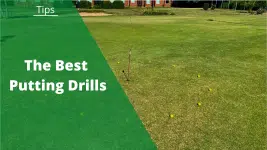Golf is a game that challenges every aspect of your life. While driving, chipping, and putting are important it is essential that you know how to hit irons.
You have to be physically fit and flexible, have a great technical ability, good feel, and be mentally strong.
Without these attributes, it is still possible to become a skillful player, but the top ball strikers in the professional ranks have worked hard in refining this aspect of their game.
This will all contribute to how to hit your irons cleanly and long. Consistency is important.
I hope that you will find this article informative and understand how you go about becoming a good iron player.
Swinging the Golf Club
A key component of the golf swing is to keep your head as steady as possible. It is nigh impossible to keep it absolutely still and this will place more stress on the swing without generating benefit.
Another key component of the golf swing is the way that you grip your golf club. Weak or strong grips will affect your ability to square the clubface at impact.
The most critical area in the golf swing is between hip height at the back and hip height at the front. This is where the action happens.
Before we discuss how to swing your irons, I want to highlight the difference between a driver swing and other swings.
The main difference is the position of the ball at address and contact point.
With a driver, you place the ball in line with your leading heel and tee it up higher than for other clubs. This will enable you to sweep the ball off the tee after your swing has bottomed out and is on an upwards trajectory.
However, with irons, you want to make contact with the golf ball slightly before the bottom of your swing. Contact with the ball first will compress the ball and increase the distance that you achieve.
The golf swing is made up of five main parts.
- Setup
- Backswing
- Downswing
- Impact
- Release
For increased consistency and distance, your swing must be driven by your body and not your arms. This lessens the number of moving parts and reduces areas that can go out of kilter.
Setup
Your setup must create a stable base for your swing to avoid you from falling over or swaying from side to side. Your swing is built by rotating around your spine therefore a solid base that prevents you from swaying is crucial.
Place your feet shoulder-width apart with your weight evenly spread between your feet. Push your knees slightly forward with your hips above your feet. Now push the gluteus maximus backward and straighten your spine.
Your head, shoulders, and feet ought to be in a straight line from the top to the bottom with your arms hang straight down.
Align your clubhead, shoulders, hips, and feet with your target. This will stand you in good stead to generate a solid swing.
Backswing
Initiate your backswing by locking the knee of your trailing leg whole moving your weight onto it. This could cause your hips to move slightly backward by a fraction of an inch. Beware not to sway at this stage.
Start the rotation with your body and not your arms. Keep your arms straight and create a wide arc. The wider the arc, the more speed you will be able to generate.
Rotate your hips pushing the trailing hip slightly upward. This rotation will pull your leading shoulder in under your chin. Keep your arms connected to your upper body. Separating your arms will create a weak swing.
To avoid making a steep swing you have to flatten the club towards the top of the swing. Be careful not to flatten it too early and get stuck behind your back.
During your backswing, your trailing wrist will cock upwards and the leading wrist will have a slight bow.
Rotate as far back as you can without straining your body or overswinging. To increase the length of your backswing you have to work on becoming more flexible.
A good position at the top of your backswing will dictate whether you can make a good downswing
Downswing
The best golfers in the world initiate the downswing before they have reached the apex of their backswing. This enables them to generate more torque, speed, and distance.
While the backswing is initiated by your upper body, the downswing is initiated by your lower body.
The first step in the downswing is to transfer your weight from your trailing leg onto your leading leg. This may cause your hips to move a fraction of an inch forward a bit you must avoid swaying too far.
Moving your body forward will also move the bottom of your swing to the front of your ball. This is extremely important for making good contact.
Start rotating your hips around your spine to create speed and keep your right elbow tucked into your hip or move it slightly in front of your body but do not create any space between the elbow and body.
Your arms should not be pulling your clubs down, but the body rotation will drag your clubs along the swing path. A good indication of whether your club is on the right plane is when the butt of your grip is pointing to the far side of the ball. If it points on the line of the ball or closer to your feet you are likely to come down steep on the ball.
Many golfers start generating speed when their hands are at shoulder height by uncocking the wrists. This is called casting and is a speed killer. Your clubhead will reach maximum speed well before it reaches the contact area.
When your clubs reached parallel to the turf, your hands should be between knee height and hip height. Your wrists remain cocked to create lag. This is a huge factor in maximizing your swing speed.
At this stage, you can start uncocking your wrist to generate maximum speed at contact.
Contact
As mentioned earlier, the bottom end of your swing is now slightly ahead of the ball due to shifting your weight onto the leading leg. This will ensure that you strike the ball before you make contact with the turf.
Ball first contact compresses the ball between the clubface and the turf generating more speed and distance. Turf contact after striking the ball generally results in a divot that will be a good indication of whether you made contact after the ball and the direction that the clubhead was moving.
Rotate your hips to push your arms through the impact area. This will square up the clubface at the point of contact. Your leading hips will now be turning towards the back and slightly upwards.
Release
The swing is not complete when you make contact. What happens after contact is a result of all the actions that you have taken up to that point.
The release should feel that you are swinging the clubhead away from your body towards the outer edge of the target and your arms are still straight.
Full extension of the arms should only occur when the clubhead is at a 45 degrees angle with the turf after contact. At full release the toes of the trailing foot could be pointing towards the target and the heel away from the target.
On a full swing, your hands should end up above shoulder height towards the back of your head. Knock-down shots played in windy conditions, or half shots will end up- in front of your body in line with the target. Your hands will probably not exceed shoulder height.
Tempo
Maintaining a steady tempo throughout your swing will increase the chances of consistency in speed and distance.
Golfers that are very armsy and initiate the swing with their arms tend to have an uneven and fast tempo while golfers that use their body to generate speed look much more at ease during the swing.
Final Thoughts
There are many intricacies in the golf swing and when understand it fully it is an amazing feeling.
However, knowing the technical detail and executing the swing consistently is two different worlds.
It is worthwhile to study the golf swing and there is always a tip that someone gives you that can improve your golf. But, beware not to listen to everyone and try and implement what they have said.
Every swing is unique, and you have to practice with a purpose to perfect your swing and improve your handicap.
Keep swinging.
Related Articles
- The Best Driving Irons; Generate The Longest Distance
- The Best Game Improvement Irons On The Market
- The Best Golf Irons For Mid-Handicappers in 2023
- Best Swing Analyzers To Improve Your Golf Game
Nick is the founder of GolfSpan and an avid golfer. He's not quite a pro but has over 15 years of experience playing and coaching golfers worldwide. His mission is to bring the golfing community a better experience when it comes to choosing the right golf gear and finding the right setup for your game.






